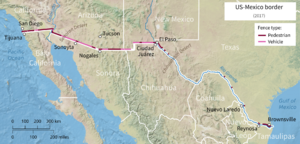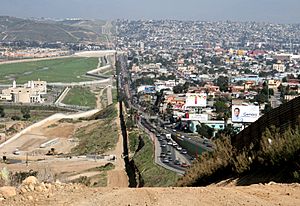Mexico–United States border wall facts for kids
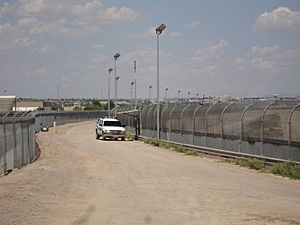
The Mexico–United States border wall is a series of barriers built along the border between Mexico and the United States. Its main goal is to help reduce people crossing into the U.S. illegally from Mexico. This barrier isn't one long wall. Instead, it's made up of different types of fences and walls.
In places where there isn't a physical barrier, security uses a "virtual fence." This means they use cameras, sensors, and other equipment to watch the border. If they see something suspicious, they send United States Border Patrol agents to check it out. As of 2011, about 649 miles (1,044 km) of barriers were in place. During Donald Trump's presidency, an extra 52 miles (84 km) of new barriers were built. The total length of the border is about 1,954 miles (3,145 km). A large part of this, 1,255 miles (2,020 km), follows the Rio Grande river. The remaining 699 miles (1,125 km) are on land. In 2022, the Biden Administration announced plans to close four large gaps in the wall near Yuma, Arizona, which is a busy area for border crossings.
Contents
What is the Border Wall Like?
The border between the United States and Mexico is about 1,954 miles (3,145 km) long. It goes through many different types of land, from cities to deserts. From the Gulf of Mexico to El Paso, Texas, the border follows the Rio Grande river, which acts as a natural barrier. The wall is built in both city areas and empty lands. These are the places where most illegal crossings have happened in the past. Cities like San Diego, California, and El Paso, Texas, have parts of the wall. For example, a steel fence, 18 to 27 feet (4.8 to 8.1 meters) high, divides the towns of Nogales, Arizona, in the U.S. and Nogales, Sonora, in Mexico.
In 2010, most people caught trying to cross the border illegally (about 97%) were caught at the southwest border. The number of people caught by Border Patrol went down from 1,189,000 in 2005 to 463,000 in 2010. This decrease was due to things like changes in the U.S. economy and stronger border security. However, the numbers started to go up again recently. In 2019, 977,509 people were caught. It's important to know that while the wall is along the Mexico-U.S. border, about 80% of the people caught crossing are not from Mexico.
Because of the wall, many people try to cross in areas where there is no fence. These areas include tough places like the Sonoran Desert and the Baboquivari Mountains in Arizona. People trying to cross these areas must travel about 50 miles (80 km) through very difficult land to reach the first road.
Where is the Border Wall?
The Mexico–United States border stretches from the Pacific Ocean in the west to the Gulf of Mexico in the east.
| US state | Border length | Mexican states |
|---|---|---|
| California | 140.4 miles (226.0 km) | Baja California |
| Arizona | 372.5 miles (599.5 km) | Baja California, Sonora |
| New Mexico | 179.5 miles (288.9 km) | Sonora, Chihuahua |
| Texas | 1,241.0 miles (1,997.2 km) | Chihuahua, Coahuila, Nuevo León, Tamaulipas |
| Total | 1,933.4 miles (3,111.5 km) | – |
History of the Border Wall
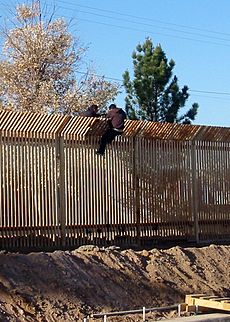
Early Barriers
The current U.S.–Mexico border was mostly set after the Mexican–American War (1846–1848) and the Gadsden Purchase (1853). For a long time, the border was open and not heavily guarded. Only a few "mounted guards" patrolled it.
However, things changed around the early 1900s. With the Mexican Revolution (1910) and World War I, there were more worries about weapons being smuggled and people crossing illegally. The first international bridge was built in 1910. The U.S. built its first barrier, a barbed wire fence, between 1909 and 1911 to stop cattle from crossing. This was in Ambos Nogales, a town split by the border. Mexico also built a wire fence there in 1918 to control where people crossed. Over the next few decades, more barriers were added, especially in border towns. By the 1940s, the U.S. Immigration and Naturalization Service built chain-link fences.
In 1978, the U.S. Congress approved money to build new fences near San Ysidro, California, and El Paso, Texas. This project was started by President Richard Nixon, who was the first president to suggest building a border fence. When the company building the fence described it as a "razor-sharp wall," it caused negative reactions in Mexico. Critics called it the "Tortilla Curtain." Mexican leaders, like President José López Portillo, spoke out against it. Even U.S. President Jimmy Carter discussed it during his visit to Mexico in 1979. Fences were built, but they were not very long and did not have razor wire.
President George H. W. Bush approved the first 14 miles (23 km) of fencing along the San Diego–Tijuana border. In 1993, President Bill Clinton continued this work, and more barriers were built during his time in office. Many of these barriers in the 1990s were made from old helicopter landing mats from the Vietnam War.
George W. Bush Administration
In 2005, there were 75 miles (121 km) of fencing along the border. That year, a college near the border, Laredo Community College, got a 10-foot (3 m) fence built by the United States Marine Corps. This fence helped reduce illegal crossings onto the campus.
In 2006, the Secure Fence Act of 2006 was signed into law by President George W. Bush. This law allowed for the building of up to 700 miles (1,125 km) of physical fences or barriers along the Mexican border. This law passed with strong support in Congress. However, the government of Mexico and leaders from several Latin American countries spoke out against these plans. The Governor of Texas, Rick Perry, also opposed it, saying the border should be more open. The city council of Laredo, Texas, voted against the barrier expansion, saying it would harm their economy.
To speed up construction, the Secretary of Homeland Security, Michael Chertoff, used a special power in 2008. This power allowed him to ignore many environmental and cultural protection laws. This meant they could build the fence faster, even if it affected wildlife or historical sites. By January 2009, over 580 miles (933 km) of barriers were in place.
Obama Administration
In 2010, the Department of Homeland Security stopped plans to expand a "virtual fence" project in Arizona. The company building it had many delays and cost problems. The remaining money was then used for mobile surveillance devices, sensors, and radios to help patrol the border.
In May 2011, President Barack Obama said that the wall was "basically complete." At that time, 649 miles (1,044 km) of the planned 652 miles (1,049 km) of barrier had been built. This included 299 miles (481 km) of vehicle barriers and 350 miles (563 km) of pedestrian fences.
A report in 2016 confirmed that the government had finished the fence by 2015. By 2017, in addition to the main fencing, there were also extra layers of pedestrian fencing in some areas.
Trump Administration
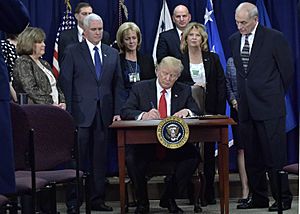
During his 2016 presidential campaign, Donald Trump promised to build a much larger and stronger border wall. He also said that Mexico would pay for it. However, Mexican President Enrique Peña Nieto stated that his country would not pay. On January 25, 2017, the Trump administration signed an order to start building the wall using existing government money.
Building the wall faced many challenges, including legal issues and funding problems. In March 2018, Congress approved $1.6 billion for about 100 miles (161 km) of new and replacement walls. From December 2018 to January 2019, the U.S. government had a partial shutdown. This happened because Trump wanted $5 billion for the wall, and Congress wouldn't approve it.
Courts also got involved. In May 2019, a judge stopped the Trump administration from using money from other government agencies to build the wall. This decision was later overturned by the Supreme Court of the United States. In September, the Secretary of Defense approved using $3.6 billion from military construction funds for 175 miles (282 km) of the barrier.
By August 2019, most of the wall construction during the Trump administration involved replacing older or damaged sections. By the end of Trump's term in January 2021, about 452 miles (727 km) had been built. Much of this replaced existing barriers.
Private Efforts
A private group called "We Build the Wall" raised over $20 million from donations to build parts of the wall. In 2019, they built a 1/2 to 1-mile (0.8 to 1.6 km) fence near El Paso on private land. The group also planned to build more barriers on private lands in Texas and California. However, a judge ordered them to stop construction in one area due to concerns about flooding.
Biden Administration
On his first day in office, January 20, 2021, President Joe Biden ordered a pause in all wall construction. The government was given time to decide how to use the money elsewhere and how much it would cost to end the building contracts. There are no plans to tear down parts of the wall that have already been built.
In June 2021, Texas Governor Greg Abbott announced plans to build a border wall in his state. He said Texas would provide $250 million and ask for public donations.
In July 2022, the Biden administration announced it would fill four large gaps in Arizona near Yuma. This area is known for having many illegal crossings.
In October 2023, President Biden announced that wall construction would restart due to a rise in migrant crossings. His press secretary said that Biden still believes the wall is "not effective." To speed up the work, the Biden administration will temporarily set aside laws that protect air, water, and endangered species. They said the money for this construction was approved during Trump's time in office in 2019.
Binational River Park
In 2021, there was a proposal to create a shared park along the Rio Grande river between Laredo, Texas, and Nuevo Laredo, Mexico. This "binational park" would be a recreational space instead of a border wall. Supporters believe it would save money and protect the river.
Arizona Container Wall
In August 2022, Arizona Governor Doug Ducey ordered a temporary wall to be built using shipping containers in Cochise County, Arizona. This construction started in a national forest without permission. Environmental groups argued that this wall harmed endangered animals like the ocelot and jaguar. The U.S. Justice Department sued Arizona to have the containers removed. Deconstruction of this container wall began in January 2023.
Environmental Impact

In April 2008, the Department of Homeland Security announced plans to ignore over 30 environmental and cultural laws to build the barrier faster. Even though officials said they would try to limit the harm to the environment, critics in Arizona, New Mexico, and Texas said the fence put endangered species and delicate ecosystems along the Rio Grande at risk.
Environmentalists were worried about how the wall would affect butterfly migration paths and the future of local wildcats, such as the ocelot, the jaguarundi, and the jaguar.
By August 2008, most of the southern border in Arizona and New Mexico had been studied. About 100 species of plants and animals, many of which are already endangered, are threatened by the wall. These include the jaguar, ocelot, Sonoran pronghorn, Mexican wolf, and a pygmy owl. Scientists say that a wall can create a "population bottleneck," meaning it can limit the number of animals in a group and cut off their natural migration routes.
In 2008, a group of scientists called The Southwestern Association of Naturalists spoke out against the wall. They said it would harm several rare and endangered species, especially mammals like the jaguar and ocelot. Ten years later, in 2018, over 2,500 scientists from 43 countries also spoke out. They said the wall would have "significant consequences for biodiversity" and that parts of the wall already built were harming animal habitats.
The wall is planned to pass through important wildlife areas like the Tijuana Slough National Wildlife Refuge in California and the Santa Ana National Wildlife Refuge in Texas. It also affects Mexico's Cabeza Prieta National Wildlife Refuge and El Pinacate y Gran Desierto de Altar Biosphere Reserve, which is a UNESCO World Heritage Site. The U.S. Customs and Border Protection plans to build the wall without doing detailed environmental studies, using a special rule from the Bush administration. This rule allows them to avoid laws like the Endangered Species Act, which normally protects wildlife.
See also
 In Spanish: Muro fronterizo Estados Unidos-México para niños
In Spanish: Muro fronterizo Estados Unidos-México para niños
- Mexico–United States border
- List of walls
- Open border
Images for kids
-
The United States Border Patrol in the Algodones Dunes, California
-
Douglas, Arizona, 2009
-
Aerial view of El Paso, Texas, (top and left) and Ciudad Juárez, Chihuahua, (bottom and right). The brightly lit border can clearly be seen as it divides the two cities at night. The dark section at left is where the border crosses Mount Cristo Rey, an unfenced rugged area.


